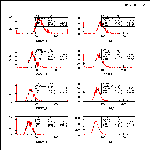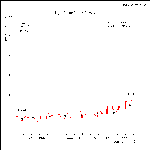
The scintillator material was delivered by JINR Dubna, Russia.
First check for quality control is the optical inspection and geometrical measurement of the scintillators. The surface should be very sleek, without scratches. The blue light from scintillation should be slightly visible by eye.
The length and width of the pieces was measured with a roll meter, which could be done to +-0.5 mm.
| Box # | Scintillator # | visual | length [mm] | width A [mm] | width B [mm] | Remark |
| 1 | U-3/2-4 | okay | 2570.0 | 299.5 | 300.0 | |
| U-3/2-6 | okay | 2570.0 | 299.5 | 300.0 | ||
| 2 | U-3/2-1 | okay | 2570.0 | 299.5 | 299.5 | |
| U-3/2-2 | okay | 2570.0 | 299.5 | 299.5 | ||
| 3 | U-7/2-5 | okay | 2559.0 | 298.5 | 298.5 | |
| U-7/2-10 | okay | 2559.0 | 298.5 | 298.5 | ||
| 4 | A-3/1-5 | okay | 2229.0 | 299.5 | 299.5 | |
| A-3/1-2 | okay | 2230.0 | 299.5 | 299.5 | ||
| 5 | U-3/1-6 | okay | 2230.0 | 299.5 | 300.0 | |
| U-3/1-12 | okay | 2230.0 | 299.5 | 299.5 | ||
| 6 | A-3/1-4 | okay | 2230.0 | 300.0 | 300.0 | |
| U-3/1-8 | okay | 2230.0 | 300.0 | 299.5 | ||
| 7 | U-7/2-6 | okay | 2558.0 | 298.5 | 298.5 | tolerance > 1.0 |
| P.(?) | okay | 2560.0 | 298.5 | 298.0 | tolerance > 1.0 | |
| 8 | U-2/2-8 | okay | 2229.0 | 299.5 | 299.5 | surface waves from polishing |
| U-2/2-7 | okay | 2229.0 | 299.5 | 299.5 | spot | |
| 9 | U-3/1-7 | okay | 2230.0 | 299.5 | 299.5 | |
| U-3/1-10 | okay | 2230.0 | 299.5 | 299.0 | ||
| 10 | U-7/2-11 | okay | 2560.0 | 298.5 | 298.5 | tolerance > 1.0 |
| U-7/2-9 | okay | 2560.0 | 298.0 | 298.0 | tolerance > 1.0 | |
| 11 | U-3/2-7 | okay | 2570.0 | 299.5 | 299.5 | |
| U-3/2-3 | okay | 2569.0 | 299.5 | 299.5 | ||
| 12 | U-2/2-6 | okay | 2230.0 | 299.5 | 299.0 | |
| U-2/2-4 | okay | 2229.5 | 299.5 | 299.0 | ||
| 13 | U-7/2-3 | okay | 2558.0 | 298.0 | 298.0 | surface (?), tolerance > 1.0 |
| U-7/2-2 | okay | 2559.0 | 298.0 | 298.0 | edge broken slightly, tolerance > 1.0 | |
| 14 | small 1 | okay | 2560.0 | 99.5 | 99.5 | |
| U-3/2-8 | okay | 2570.0 | 300.0 | 300.0 | ||
| 15 | U-3/1-13 | okay | 2229.0 | 300.0 | 299.5 | |
| U-1/1-9 | okay | 2230.0 | 299.5 | 299.0 | ||
| 16 | U-2/2-5 | okay | 2229.0 | 299.0 | 299.0 | |
| U-7/2-4 | okay | 2228.0 | 298.0 | 298.0 | tolerance > 1.0 | |
| 17 | U-3/1-11 | okay | 2229.0 | 299.5 | 300.0 | scratch |
| A-3/1-3 | okay | 2230.0 | 299.5 | 299.5 | ||
| 18 | U-2/2-2 | okay | 2228.0 | 157.0 | 158.0 | tolerance > 1.0 |
| U-2/2-1 | okay | 2229.0 | 158.5 | 159.0 | tolerance > 1.0 |

The attenuation length of the new scintillators has to be measrued for a few pieces. The principle of the measurement is close to the setup used for the the Mirror Readout Test. The scintillator is wrapped reflective by Aluminium foil and lighttight with cloth. On one end a Burle 1'' PM is coupled via optical compund to the scintillator (see figure 1). The two trigger counters indicating the pass of a cosmic particle are the same as in the mirror test measurement.

Figure 1: Test setup. The Scintillator counter has two trigger counters on top and on bottom (parameters see below).
PM tube: Burle S83062E (as Pibeta Plastic Veto readout)
HV: 1520 V (-)
optical coupling to the scintillator: optical compound Dow Corning Q2-3067
Trigger counters:
Size: 20 x 75 x 95 mm^3
PM tube: Hamamatsu R 5600 directly attached to the scintillator
HV: ~920 V
discriminator threshold: 20 mV

Figure 2: Pulse height spectra for different trigger counter positions

Figure 3: Light Collecion: Data and MC from LICOBIX. One can extract an attenuation length of 2600 mm for the scintillators. This picture is also available as PS-file.

H.P. Wirtz , 21-Oct-1999
last update: 19-Apr-2000

Paul Scherrer Institut (PSI) WWW Information Services, Home
Page
Pion Beta Experiment Home Page